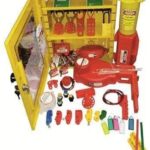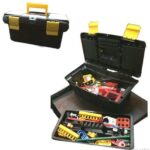Your list is empty, add products to the list to send a request
What Are the Two Types of Fire Panels?

12
Aug
Fire alarm panels are the heart of any fire detection system. They receive signals from detectors, process them, and trigger alarms to alert building occupants. But not all panels are the same. In fact, there are two primary types of fire panels—each with its own strengths, costs, and ideal applications.
In this article, you’ll learn the differences between these two systems, how they work, and which one is right for your building. By the end, you’ll be able to make an informed choice that balances safety, compliance, and budget.
Why Understanding the Types of Fire Panels Matters
Choosing the wrong panel could lead to inefficient fire detection, higher costs, or even compliance issues. Fire safety regulations often require that the chosen system matches the building’s size, layout, and risk profile.
Knowing the two main types—conventional fire panels and addressable fire panels—will help you pick the most effective solution for your needs.
The Two Main Types of Fire Panels
1. Conventional Fire Panels
A conventional fire panel is the simpler of the two main types. It divides your building into zones, with each zone wired to detectors and call points.
How it works:
When a detector is triggered, the panel displays which zone is in alarm. This tells you the general location of the fire but not the exact device.
Key features:
- Multiple zones (often 2 to 32)
- LED indicators for fire, fault, and power status
- Simple controls for silencing and resetting alarms
- Lower cost compared to addressable systems
Best for:
- Small to medium buildings
- Properties where zoning is sufficient for safety
- Budget-conscious installations
One example is the Ravel RE-9016 Conventional Fire Alarm Panel – 16 Zones, designed for reliable performance and straightforward operation.
2. Addressable Fire Panels
An addressable fire panel takes things a step further. Instead of just showing the zone, it identifies the exact device that triggered the alarm.
How it works:
All devices are connected on a single loop, each with its own digital address. The panel communicates with each device individually, making it easy to locate the problem.
Key features:
- Pinpoint accuracy for alarm locations
- Advanced diagnostics and monitoring
- Greater scalability for large or complex buildings
- Higher upfront cost but better long-term efficiency
Best for:
- Large buildings or multi-site facilities
- High-risk environments like hospitals or data centres
- Projects where minimising false alarms is a priority
Conventional vs Addressable Fire Panels – At a Glance
| Feature | Conventional Fire Panel | Addressable Fire Panel |
| Detection Level | Zone-based | Device-specific |
| Wiring | One circuit per zone | Loop wiring for all devices |
| Cost | Lower | Higher |
| Maintenance | Simple | More technical |
| Best For | Small to medium buildings | Large or complex facilities |
Choosing the Right Fire Panel for Your Building
When deciding between the two types of fire panels, consider:
- Building Size – Larger buildings benefit more from addressable systems.
- Budget – Conventional panels are more affordable upfront.
- Risk Level – High-risk sites often require faster, more precise detection.
- Future Expansion – Addressable systems are more scalable.
- Regulatory Compliance – Check local fire codes before deciding.
Installation and Maintenance Considerations
Regardless of the panel type you choose, installation and maintenance are critical.
Installation tips:
- Use qualified fire alarm engineers.
- Ensure wiring meets standards (e.g., BS 5839).
- Test all zones or devices after setup.
Maintenance tips:
- Monthly: Test at least one detector or call point.
- Quarterly: Check batteries, sounders, and fault indicators.
- Annually: Test the full system.
Frequently Asked Questions
1. What are the different types of fire panels?
There are two main types: conventional fire panels and addressable fire panels. Conventional panels identify the zone in alarm, while addressable panels pinpoint the exact device.
2. Can a building have two fire alarm panels?
Yes. Large or complex buildings may use multiple panels, either linked together or operating independently, to cover different areas or systems.
3. How many detectors are in a fire alarm system?
This depends on the building’s size, layout, and regulations. A single zone in a conventional system might have several detectors, while an addressable system can handle many more on a single loop.
Final Thoughts
Both types of fire panels play a crucial role in protecting lives and property. A conventional panel offers simplicity and affordability, while an addressable panel provides precision and scalability.
If you’re looking for a reliable, easy-to-use option, the Ravel RE-9016 Conventional Fire Alarm Panel – 16 Zones is a solid choice for many buildings.
Explore our full range of fire panels and get expert advice on choosing the perfect system for your safety needs.
Your safety starts with the right panel—make the right choice today.



























